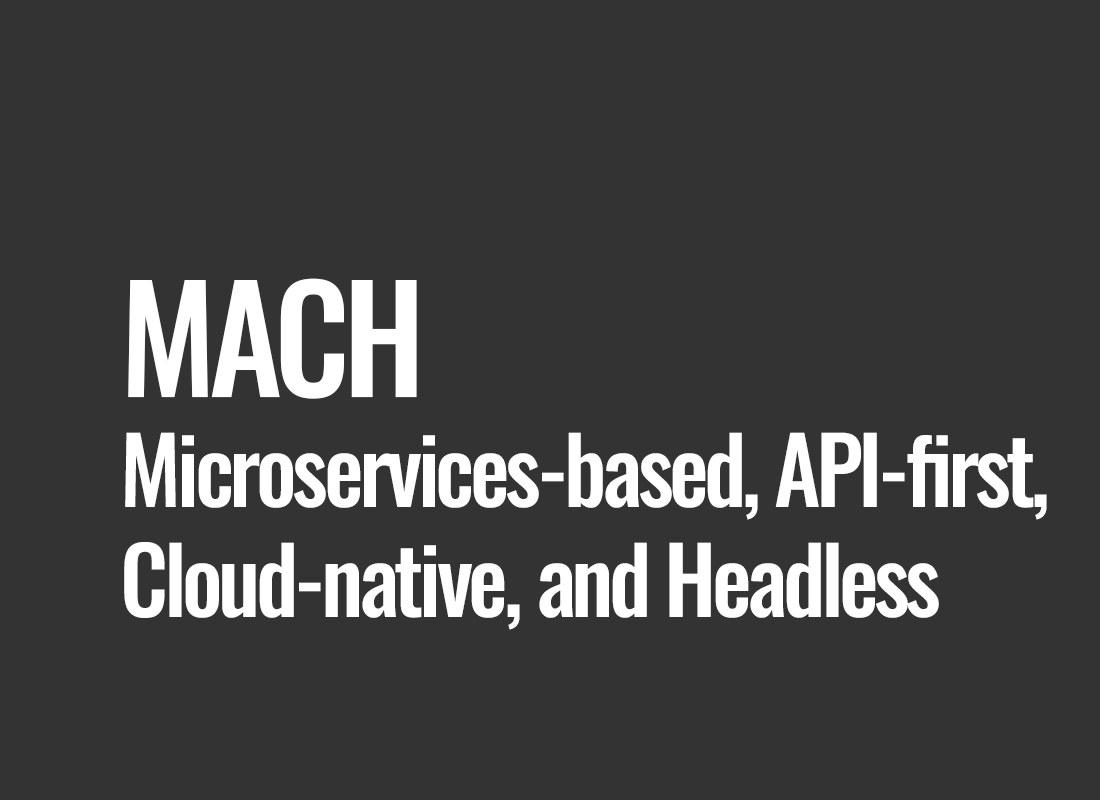MACH (Microservices-based, API-first, Cloud-native, and Headless)
In today's dynamic digital world, technology plays a pivotal role in online business development. One of the latest and most promising approaches to designing and implementing e-commerce systems, marketing applications, and IT solutions is MACH. This acronym stands for Microservices-based, API-first, Cloud-native, and Headless. These principles underpin the modern revolution in e-commerce, marketing, and IT. In this article, we'll delve into this technology, look at its key aspects, and present numerous examples to demonstrate how MACH is transforming online businesses.
The traditional approach to designing and implementing online solutions relies on monolithic structures, which are challenging to scale, modify, and adapt to current market needs. Nowadays, to stay competitive in the online market, it is no longer enough to use traditional, monolithic e-commerce systems or marketing solutions. We need flexibility, scalability, and speed that adapts to changing market conditions. In this context, MACH emerges.
MACH is not just another tech acronym. It represents a philosophy that emphasizes innovation, efficiency, and customer-centric adaptation. This approach allows for the creation of solutions that not only meet current standards but are also ready for future challenges. That's why MACH is gaining popularity in e-commerce, marketing, IT, and many other fields.
It's worth noting that MACH is not just a set of technological tools but primarily a change in thinking about designing and implementing online solutions. This approach unleashes creative energy and enables experimentation with new ideas without burdening the organization with cumbersome structures and processes. It's also a response to modern customers' needs, who expect personalized, easily accessible, and reliable online services.
MACH - A modern revolution in online business
In today's era, to remain competitive online, it's not enough to rely on traditional, monolithic e-commerce systems or marketing solutions. We need flexibility, scalability, and agility to adapt to changing market conditions. This is where MACH comes in.
Microservices
The first key element of MACH is a microservices-based approach. Traditional monolithic systems resemble colossal buildings, hard to modify and expand. Microservices revolve around breaking down an application into smaller, independent components. Each microservice is responsible for a specific functionality, making it easier to scale, maintain, and develop the system.
For instance, if you run an online store, microservices allow you to separate order handling from inventory management. This means you can scale order processing during peak times without tampering with other system components. It also facilitates making changes and updates, as there's no need to modify the entire monolith.
API-first
The next key element of MACH is the "API-first" approach. This means that every system functionality is made available through Application Programming Interfaces (API). This allows various application components to communicate in a decentralized and flexible manner, facilitating the creation of personalized solutions, integrations with other tools, and ensuring scalability.
For instance, in an e-commerce system, APIs can facilitate easy integration with payment systems, logistic service providers, and other tools, creating a cohesive and integrated shopping environment for customers.
Cloud-native
MACH also emphasizes a "Cloud-native" approach. Systems based on MACH are designed and deployed in the cloud. Using cloud resources provides flexibility in adjusting resources to current needs, ensuring scalability, and high availability. Moreover, it results in cost savings related to infrastructure, especially vital for small and medium-sized enterprises.
For example, cloud infrastructure can adjust computational power based on customer activity during promotional or holiday online shopping periods, eliminating server overload risks and potential customer loss due to website unavailability.
Headless architecture
The last, but not least, element of MACH is its "Headless" architecture. In traditional e-commerce and marketing systems, the front-end (what users see) is tightly linked with the backend (the business logic and database). In the "Headless" approach, these layers are separated. This enables easy changes in the user interface without tampering with the business logic, speeding up the delivery of new features and services.
For instance, for an online store website, thanks to the "Headless" architecture, you can quickly change the site template without needing to alter the order handling or product management systems.
MACH application examples
E-commerce
MACH is revolutionizing e-commerce, enabling companies to build flexible and scalable e-commerce platforms. Shopify, for instance, adopted MACH to allow online merchants to tailor their stores to individual needs and quickly deploy new features. This lets online stores promptly respond to market trends and offer unique shopping experiences.
Marketing
In marketing, MACH facilitates the personalization of customer experiences and marketing automation. HubSpot, using MACH, provides tools for creating personalized marketing campaigns and analyzing results in real-time. This enables companies to offer tailored content and deals, enhancing the efficacy of marketing campaigns.
IT
In the IT sector, MACH enables companies to provide applications and services with high availability and flexibility. Amazon Web Services (AWS), using MACH, delivers a cloud infrastructure that allows businesses to scale resources as needed. This means companies can easily adjust their IT environments to changing market conditions and client requirements, preventing excessive infrastructure investments and ensuring service efficiency.
Conclusion
Introducing the MACH approach (Microservices-based, API-first, Cloud-native, and Headless) is transforming online businesses by providing them flexibility, scalability, and agility to adapt to changing market conditions. Through microservices, the "API-first" approach, "Headless" architecture, and cloud utilization, companies can craft innovative e-commerce, marketing, and IT solutions. Examples from companies like Shopify, HubSpot, and Amazon Web Services demonstrate that MACH not only promises a revolution but is already delivering it. This methodology is the key to success in the digital era and constitutes the foundation of modern online businesses. For firms brave enough to undergo a MACH-aligned transformation, new opportunities await, and the future looks even more promising.




